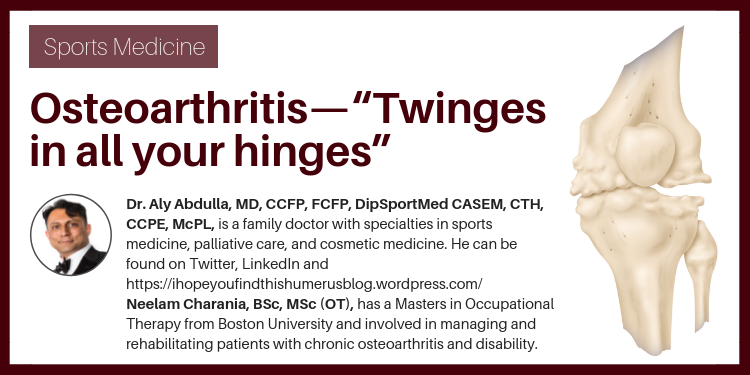The year 2000 was a memorable one for me, but not necessarily in a positive manner. I woke up on the morning of February 29 (I will never look favourably on leap years again), with pain in the lateral side of my right knee. Being an astute clinician, and one who has considerable expertise in mobility disorders, I did the obvious thing: I ignored the pain, and continued to do everything as I always did (admit it, you would have done the same). By the end of the week, the pain was so severe that I could no longer exercise. Walking from the office to the hospital ward became a daily torture. I consulted an excellent rheumatologist who was puzzled by the lack of physical findings (except tenderness) and unimpressive x-ray results. An MRI, however, revealed severe bone marrow edema and bone loss in the medial femoral condyle. The picture was absolutely typical for a rare disorder called 'transient regional osteoporosis.' In typical physician manner, I had selected an unusual disease that was rarely seen (fortuitously my rheumatologist had written a paper on the topic a decade earlier, the last time he had seen the disease). I was embarrassed to find out that I, an internist, had developed an internal medicine disorder of which I had never even heard! After my films were reviewed by every orthopod and rheumatologist in the hospital, the consensus was that the bone was in great danger of breaking, and I would have to be completely non-weight bearing!
The pain started to ease as soon as I kept off my leg completely, but I was then in the position of so many of my patients: my life was tremendously constrained because of my lack of mobility. Survey after survey has revealed that the single greatest factor impairing quality of life in the elderly is arthritis, usually osteoarthritis. However, as physicians we often ignore these complaints and frequently do not even properly examine the joints. We are more concerned about the life-threatening disorders such as cancer and heart disease, or disabling neurological disorders such as stroke or dementia. These are of course crucial issues, but painful joints also require careful attention. As I struggled up stairs, learned how to use a shower stool, and continuously complained about my restrictions, I began to understand a little more clearly the problems experienced by so many of my patients. I was also surprised that my usual cheerful disposition (okay, there is some dispute about that) evaporated. I was depressed, and even though my ability to do paper work was theoretically unimpaired, my concentration and initiative were clearly decreased. The side effects of drugs I experienced could fill an entire article on their own.
I am, therefore, quite pleased that this edition of Geriatrics & Aging is focussing on arthritic disorders. Several years ago, David Naylor (currently Dean of Medicine at the University of Toronto), in his Gold Medal address to the Royal College of Physicians and Surgeons of Canada, commented on the under utilization of joint replacement in Canada. I suspect that this is still the case. Dr. Mahomed and Dr. Hawker will update us on this valuable surgical approach for the elderly. Most elderly persons will not have surgery for their osteoarthritis, and Dr. Tenenbaum discusses the medical management of these patients. There are articles on new treatments for arthritis (de los Reyes et al.), non-pharmacological therapy (Lineker), innovative programs (Malik) and the treatment of rheumatoid arthritis (Juby and Davis) and polymyalgia rheumatica (Little). In addition, there are articles on psychotropic medication use in the elderly (Conn), herb drug interactions (Dergal and Rochon), pharmacokinetics (Turnheim), and atrial fibrillation (Burstein). Also included in this issue is an article on the global aging phenomenon (Keller and Kalache), and the use of the Internet by seniors (Ryan).
Back to my personal problems, you might ask what was the most important lesson I learned from my travails last year. I would sum it up this way: have a wonderful spouse and family to care for you, and tremendous colleagues to shoulder your burden of work. Also, I learned to be very thankful for the word 'transient' in my diagnosis of transient regional osteoporosis.
Enjoy this issue.

